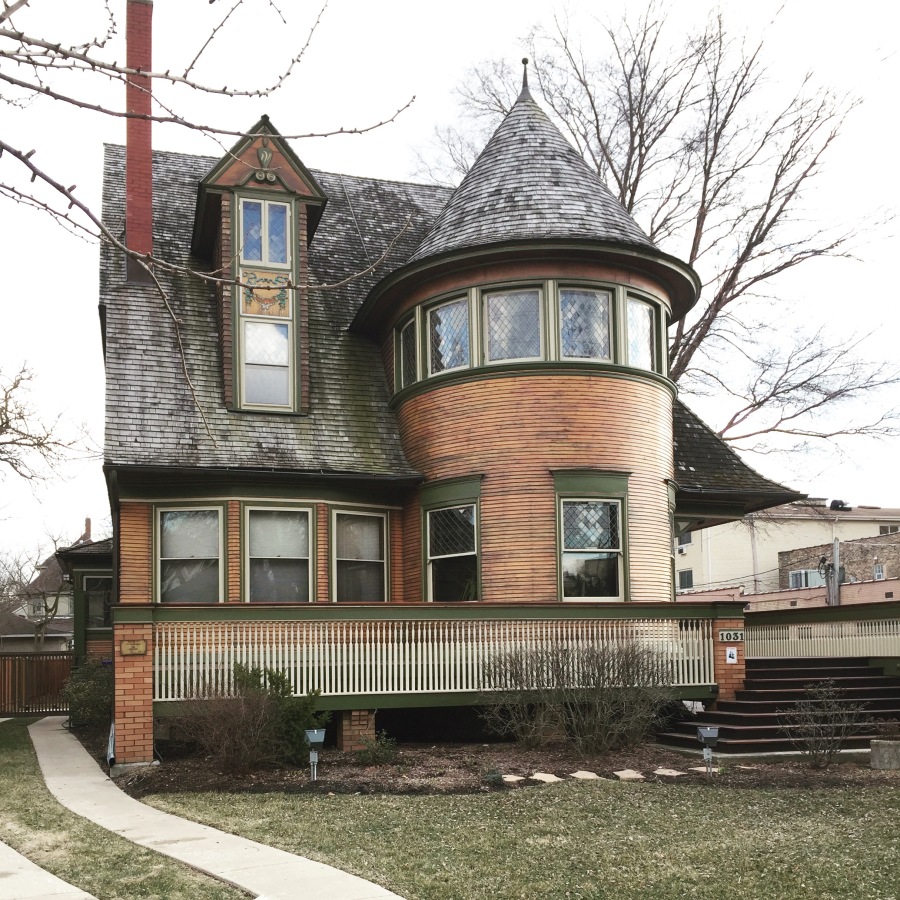Three houses stand on the south side of Chicago Avenue, just a block from Frank Lloyd Wright’s home and studio, that stand out slightly from their surroundings. They aren’t average suburban houses but they aren’t obvious Frank Lloyd Wright designs, either. What’s the deal?
These three houses are known as Frank Lloyd Wright’s “bootleg houses.” In 1892, when Wright designed the first two of these houses, he was working for the firm of Adler & Sullivan and had a strict agreement that he could not take outside commissions. Rather, he was required to work strictly for the firm. Did he? Of course not. Wright took these commissions on the side and, story has it, Sullivan himself came across one of these houses and immediately knew it had been designed by Wright. Sullivan always said that he fired Wright and Wright maintained that he quit. Not matter which side of the story you believe, it was with these three houses that Wright struck out on a career of his own.
The bootleg houses are noteworthy because they show a transitional period in Wright’s design, when he was testing new design ideas but before he had truly embraced the Prairie Style. If you’re ever in Oak Park, take a moment away from Wright’s more famous designs and head down Chicago Avenue. It’s there you will catch a glimpse of a different piece in the story of architecture by Frank Lloyd Wright.

The Robert Parker House (1892). Wright’s preference for large, simplified geometric shapes is very apparent in the Parker house. This is also an example of one of many octagonal spaces Wright designed, including an octagonal library in his Oak Park studio (one of his first designs) and an octagonal skylight in the Guggenheim (one of his last).

The Thomas Gale House (1892). This house has Queen Anne elements but with minimal decoration, suggesting Wright’s future design direction.

The Walter Gale House (1893). This house is one of the first designed by Wright after he departed from Adler & Sullivan. It has some Queen Anne elements but shows some precursors to Prairie style in the geometric shapes, hidden front door, and ribbon windows.
Sources and Further Reading:
You can find individual details about all of Wright’s Chicago buildings on the Frank Lloyd Wright Trust site, here. This includes the Thomas Gale House, the Robert Parker House, and the Walter Gale House.
I’ve written about Frank Lloyd Wright before! Check out some of my previous pieces (and visit my Explore page for more):
- S.C. Johnson: the Wright Office Building
- The Robie House’s Contemporary Reflection
- Views of Unity Temple
- Ravine Bluffs: A Century-Old Frank Lloyd Wright Development
- If You Ask Frank Lloyd Wright for Tudor Revival
- Celebrating Frank Lloyd Wright’s Birthday (with views from Oregon’s Gordon House)
- What Came Before Prairie Style (a peek into the other buildings in Frank Lloyd Wright’s Oak Park neighborhood!)
Which do you prefer? The later Prairie style buildings or these early designs by Frank Lloyd Wright?

The first two are so similar.
LikeLiked by 1 person
They do! I was trying to identify them in some historic photos and had trouble finding differences. I wonder if the interiors are as similar as the facades.
LikeLiked by 1 person
“You can’t fire me, I quit.” Chortle! Is that phrase attributed to Wright?? But what about construction permits — no permits for these houses? What about the builder/contractor — someone often traced to Wright?
LikeLiked by 1 person
Haha probably so! Wright had an accomplice—an architect he had worked with previously, named Cecil Corwin. It was Corwin that signed off on everything as the architect (though of course he wasn’t).
LikeLiked by 2 people
Beautiful
LikeLiked by 1 person
Thanks! They are gorgeous little houses.
LikeLike
I’d heard about these houses, so enjoyed seeing them. They’re beautiful! You say “little” … They look pretty big to me. Are you comparing them to other houses in the neighborhood?
LikeLike
[…] 1. Frank Lloyd Wright’s Bootleg Houses […]
LikeLike